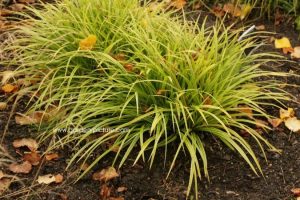
- Common Name: Japanese grass sedge
- Type: Rush or sedge
- Family: Cyperaceae
- Zone: 5 to 9
- Height:00 to 1.50 ft.
- Spread:50 to 2.00 ft.
- Bloom Time: April to July
- Bloom Description: Brown
- Sun: Partial shade to full shade
- Water: Medium to wet
- Maintenance: Low
- Suggested Use: Ground Cover, Naturalise, Rain Garden
- Flower: Insignificant
- Leaf: Colourful
- Tolerate: Deer, Heavy Shade, Erosion, Wet Soil
A. Culture:
Best grown in moist, fertile, medium to wet soils in partial shade to full shade. Soil should not be allowed to dry out. Foliage colour is sharper and richer in shady conditions. Foliage may bleach to unattractive shades of yellow when these plants are grown in full sun. This sedge is evergreen in the deep South (USDA Zones 8 to 9), but is not evergreen near the northern edge of its growing range (for example, the St Louis area), although some foliage colour may persist through mild winters. Where the sedge is not evergreen, foliage should be cut to the ground and removed in late winter. Propagate by plant division in spring or seeding in the fall.
This sedge may be grown as a container plant using a mixture of one-half peat moss and one-half fertile soil that needs to be kept constantly moist but well-drained.
B. Noteworthy Characteristics
Carex morrowii, commonly known as Japanese sedge or Morrow’s sedge, is a sedge that typically grows in a dense, grass-like clump to 1 to 2’ tall. It is native to low alpine areas in Japan. This sedge is typically grown for its attractive shape and foliage. Plants feature stiff, flat, narrow, long-pointed, solid green leaves (1/2” wide to 12” long). Brownish flowers (that lack petals and sepals) are short-lived and inconspicuous.
Genus name from Latin means cutter in reference to the sharp leaves and stem edges (rushes are round but sedges have edges) found on most species plants.
Specific epithet honours Dr James Morrow who collected this plant in Japan as a member of the US Expedition led by Commodore Perry in 1853 to 1854.
The common name sedge comes from the Latin word ‘secafre’, which means to cut, in reference to the sharp leaf edges. An old saying is worth repeating here: “sedges have edges, and rushes are round; but grasses have nodes from their tips to the ground.”
‘Variegata’ features narrow deep green leaves (up to 18” tall) with creamy white margins.
C. Problems
No serious insect or disease problems.
D. Garden Uses
Group or mass as a ground cover in shaded areas of borders or woodland gardens. Grows well in the shade of trees. Effective accent for smaller gardens. Also appropriate for areas with moist soils such as low spots and stream/pond margins. Most effective when grown in large clumps or massed plantings, although smaller clumps can be attractive in shaded areas of rock gardens. Good in containers.
Share with:

